Dental Implants – Waverly, OH
A Comprehensive Way to Replace
Teeth

Dentures and dental bridges can fill in the space left by missing teeth, but since they don’t replace the lost tooth roots, they can’t perform all the same functions that your natural teeth do. If you want new teeth that are as much like your original teeth as possible, your best option is dental implants. If you’re eligible for this treatment, it can be the best option for replacing any number of teeth. Give us a call to schedule a consultation at Corcoran Privitera Family Dental and see if dental implants in Waverly are right for you.
Why Choose Corcoran Privitera Family Dental for Dental Implants?
- In-House Dental Implant Placement
- Non-Judgmental, Patient Dentists
- Down-to-Earth, Transparent Dental Team
What Are Dental Implants?
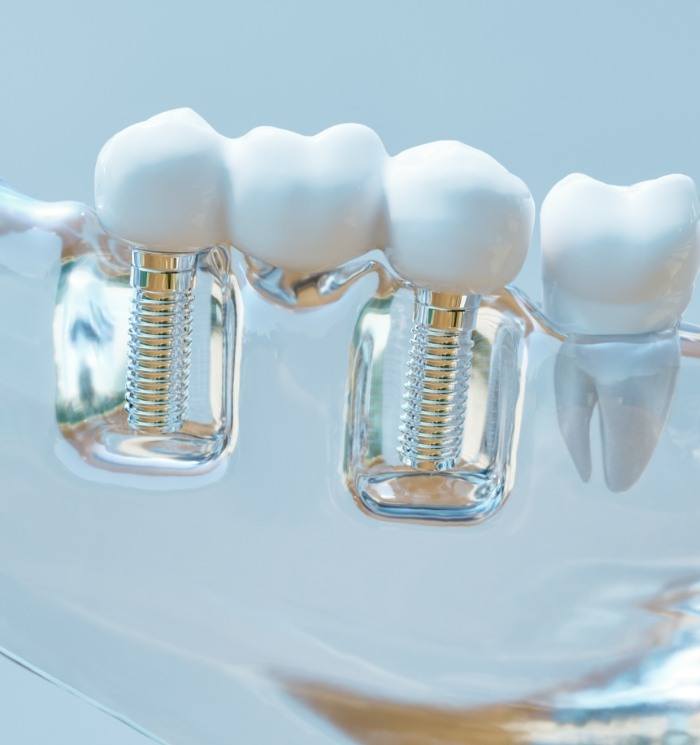
A dental implant is basically a small post shaped like a screw that is placed in the jawbone and supports one or more prosthetic teeth via a dental crown, bridge, or denture. Most dental implants are made out of titanium, a highly durable, biocompatible substance that can fuse with your jawbone and last for several decades. Dental implants act as artificial tooth roots so that your new restoration always stays in place and feels like a natural part of your mouth.
The 4-Step Dental Implant Process

To rebuild your missing teeth with dental implants, you’ll typically expect multiple steps to be involved to make your treatment effective and long-lasting. The good news is that your results can provide further benefits compared to traditional prosthetics, making this procedure incredibly worthwhile. Our team will walk you through the entire process during your first visit so that you know exactly what to expect. Until then, here are the four main steps in the dental implant treatment.
Initial Dental Implant Consultation
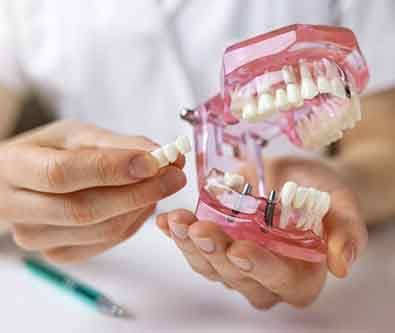
The process begins with a consultation with our team, where we will check to make sure your mouth and jawbone are healthy enough for dental implants. Any problems that might complicate the dental implant process will need to be dealt with before we can move forward. This means that if you have an issue with periodontal disease or you don’t have sufficient jawbone density, we might have to prepare your mouth with services like gum disease treatment, bone grafting, or even tooth extractions.
After we’ve confirmed that you’re mouth is problem-free, we can move on with your placement procedure.
Dental Implant Surgery
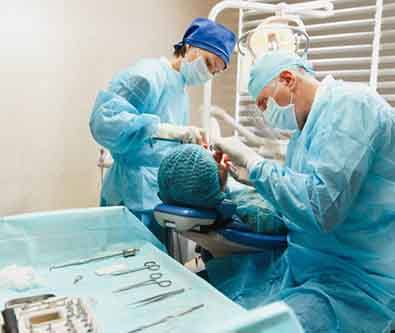
The next step is dental implant surgery, which is performed right here in our dental office, so you won’t have to worry about traveling to different locations to get the care you need. To begin with, we’ll provide you with a local anesthetic so that you’re pain-free during your procedure. We might even administer/prescribe you sedation dentistry to further relax you and keep you comfortable. After your mouth is numb, your surgeon will make small incisions in the gums to reach the jawbone area where they’ll place your implant(s) before suturing the gums closed around them. We’ll place a protective cap on top of the post and send you home so that you can recover.
Dental Implant Osseointegration & Abutment
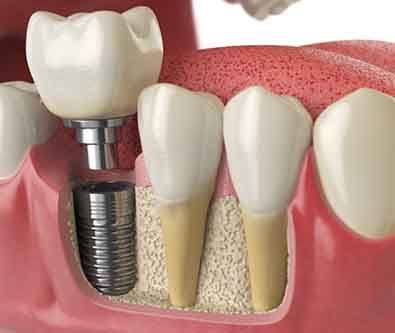
It’ll take about three to six months for the implant posts to join with your jaw via a natural process called osseointegration. Once this occurs, you can expect your implants to be exceptionally stable, providing your future teeth with the lifelike support necessary for optimal biting power.
After you’ve healed completely, you’ll return to our office to have your fully integrated dental implants topped with abutments—small metal connector pieces that link your restorations to your metal posts. Then, after your mouth has healed, we can take impressions to design your final restoration.
Delivery of Dental Implant Restoration(s)

At your last appointment, we’ll attach your new dental crown, bridge, or denture to your implants after we’ve made any necessary adjustments. We’ll confirm that your bite is correct and that you’re happy with the results of your treatment before sending you on your way. Our team will also provide you with aftercare instructions so that you can make the most of your new smile for many years to come.
Benefits of Dental Implants

- Versatility – Dental implants can be used to replace any number of teeth.
- Full Diet – You can eat all your favorite foods without restriction thanks to the stability and strength of dental implants.
- Jaw Health – Dental implants can actively prevent bone loss in your jaw.
- Easy Maintenance – You can brush dental implants as if they were natural teeth, which can help improve your overall oral health.
- Longevity – Properly cared-for dental implants can last for several decades or even an entire lifetime.
Who Dental Implants Can Help
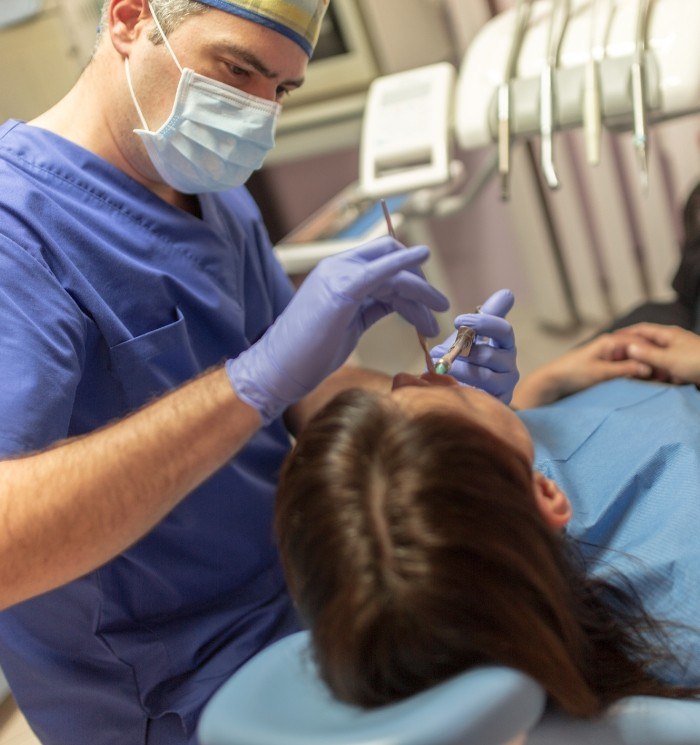
Most adults with healthy mouths, jaws with plenty of bone density, and at least one missing tooth can be considered candidates for dental implants. Even if you can’t get implants right away, there might be preparatory procedures that help make the treatment viable. We can help you figure out whether you’re able to get dental implants during your first consultation, and we can suggest a number of dental implant treatments based on how many teeth have been lost.
Dental Implant
Treatment Options
Missing
One Tooth
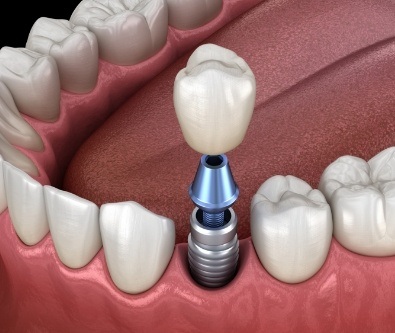
Missing One ToothIf you are missing just one tooth, we can fill the space with a single dental implant post. A dental crown can be attached to the post once your mouth has healed. Single dental implants can be a good alternative to traditional dental bridges because we don’t have to make any alterations to the surrounding teeth to place a new one.
Missing
Multiple
Teeth
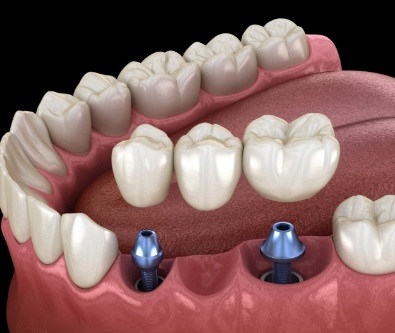
Missing Multiple TeethThree or more consecutive missing teeth can be replaced with a dental bridge and two dental implants. Each implant post will be placed at either side of the gap so that they can support the crowns at the end of the bridge. Implant bridges tend to be more durable than traditional bridges, and they will prevent your natural teeth from drifting out of place.
Missing All
of Your
Teeth

Missing All Your TeethA full denture can be attached to your mouth with just four to eight dental implant posts. (The exact number varies depending on the patient.) Your dentures will stay securely in place at all times; unlike traditional dentures, you won’t have to worry about your new teeth slipping at the wrong moment when you have implant dentures.
Understanding the Cost of Dental Implants

Getting dental implants is a significant investment, so we will take the time to explain the factors that go into the final cost. The number of implants needed and whether preparatory treatments are performed first help determine the amount you end up paying. Remember that dental implants have long lifespans and can stay in your mouth for decades, so you will not have to pay to replace them as often as traditional dentures and bridges. Ultimately, this makes dental implants in Peebles a more cost-effective tooth replacement solution in the long run.
Dental Implant FAQs
Will I Have to Take Off Work for Dental Implant Surgery?
Whether you should take off work or not depends on the kind of work that you do, how many dental implants you’re getting, and how quickly you’re able to heal. That said, most dental implant surgery isn’t all that invasive, so you won’t be out of commission for long.
Most people only need to take one day off of work, two at most. It’s recommended that you rest up for around 24 hours after surgery, but beyond that, you shouldn’t have many problems.
However, you should try and avoid vigorous exercise for at least the first three or four days, so people whose work is physically demanding should plan to take at least that much time off.
Can I Get Dental Implants If I Smoke?
Dental implants have a pretty high success rate, but smokers are at a significantly higher risk of failure than other patients. Tobacco use decreases blood flow in the mouth and hinders the ability of the implant wound to heal. Smoking can also pull the blood clot out of the implant site, leading to a condition known as dry socket.
For these reasons, it’s strongly recommended that you quit smoking for at least two weeks before the surgery and at least 90 days afterward. And of course, the best thing to do is to quit for good.
Is There Anything I Shouldn’t Eat with Dental Implants?
Immediately after dental implant surgery, it’s a good idea to avoid any foods that are tough, hard, or difficult to chew. You should steer clear of anything excessively sugary and acidic. It’s also good to avoid drinking alcohol. Finally, drinking through a straw can cause dry socket, so you shouldn’t do that while healing either.
After you’ve healed completely, you can eat anything you could with your natural teeth. Of course, excessively sugary or hard foods can cause problems, so you should be careful when eating them. That said, dental implants are stable enough to handle most foods.
How Soon After a Tooth Extraction Can I Get Dental Implants?
If you have a perfectly healthy jaw, there are some situations where you could get a dental implant immediately after a tooth extraction. However, we usually don’t recommend this. It’s generally better to wait for the extraction area to heal before placing the dental implant, which should take anywhere from three to six months.
If you wait too long, it’s possible that your jawbone can start to shrink, which can make it difficult to place the dental implant. We’ll talk with you specifically about when we think that the time is right to conduct the surgery.
